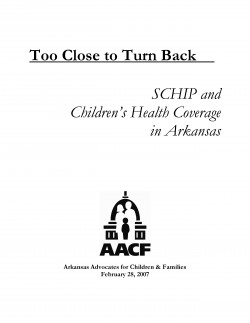
In 1997, with the enactment of Title XXI of the Social Security Act, the State Health Insurance Program (SCHIP) was created with strong bipartisan support. Initially authorized as a 10-year program, SCHIP has become widely regarded as one of the greatest recent social policy successes. SCHIP was crafted to provide affordable health care coverage to low-income children who are financially ineligible to receive coverage under Medicaid.
The federal government provided states the financial support (nearly $40 billion) and flexibility needed to expand publicly funded coverage to children. It authorized states to use federal SCHIP funds to extend coverage beyond Medicaid by expanding eligibility levels (as was done in Arkansas), by creating a separate children’s insurance program (as was done in Mississippi and Texas) or through a combination approach (as is the case of Florida). Unlike Medicaid, federal funding for SCHIP is capped. States receive an enhanced federal match rate 65% to 85% for its SCHIP related initiatives (Arkansas’ SCHIP federal rate match is almost 82%), up to a capped allotment determined through a formula that takes into account a state’s share of low-income children and uninsured, low-income children. If a state does not use its annual allotment of SCHIP funds within a period of three years, the unspent funds are redistributed to other states.
Although funding for SCHIP is set to expire in September 2007, Congress has the opportunity to reauthorize the program to build upon the success of the last 10 years and provide the resources needed to further narrow the coverage gap for children. Since the inception of SCHIP, the number of uninsured children in this country has decreased by one-third. Currently, 28 million children receive coverage through Medicaid and 6 million receive coverage through SCHIP-financed Medicaid expansions or separate SCHIP programs. Despite the success of Medicaid and SCHIP, 8.3 million children under the age of 18 remain uninsured. And for the first time since 1998, the number of children without health insurance coverage rose by 360,000 children, climbing from 10.8 percent of children in 2004 to 11.2 percent in 2005. Nearly 70 percent of uninsured children live in families with incomes under 200 percent of the federal poverty level (which translates to $40,000 for a family of four and $31,000 for a family of three). As a result of coverage expansions, most of these children are now eligible for Medicaid or SCHIP.
SCHIP was designed to provide health coverage for children that fall between the gap of publicly funded Medicaid and private insurance. The original goal was to cover 5 million children by 2007. In 2006, 6.1 million children were enrolled in SCHIP. The latest information released by the U.S. Census Bureau indicates that the number of uninsured kids has increased for the first time since 1998. Current estimates reveal that approximately 9 million children nationwide are without health insurance, of which 74 percent are eligible to enroll in Medicaid or SCHIP.
As a result of SCHIP and other initiatives, Arkansas has been a national leader in reducing its ranks of uninsured children, from over 20% in 1997 to 10% today. Today, nearly 65,000 Arkansas children receive coverage through SCHIP.
In 2007, Congress will face opportunities and challenges to make advancements in meeting the health care needs of children through reauthorization of the State Children’s Health Insurance Program (SCHIP). The reauthorization of SCHIP will have major implications for Arkansas’ future efforts to provide health care coverage for all children. In 2011, Arkansas will join the ranks of 3 states that face a financial shortfall in its SCHIP program unless funding is increased. Without additional funding, the state will face tough choices about how to make up the shortfall, such as serving fewer children and/or cutting benefits.
